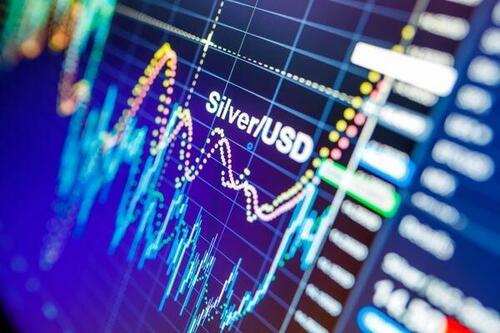
Doug Casey On Silver: Money, Markets, & The Metal’s Role In The Coming Chaos
Via InternationalMan.com,
International Man: What is it about silver that makes it viable as a monetary metal—that is, something people actually use to store and exchange value?
Doug Casey: Let’s look at the definition of what makes a good money. There are basically six characteristics. A good money has to be durable, divisible, convenient, consistent, have use value, and some limit on supply. Using those six key characteristics, gold ranks first, silver second, and copper third. That’s why those three metals have been preferred money throughout history. They were superior to seashells, salt, cows, paper, and other commodities. In today’s world it makes sense to bring Bitcoin, which also satisfies those six characteristics into the mix.
So, to answer the question: Silver has always been a monetary metal, and it likely always will be.

International Man: Do you think gold functions better as money than silver—and if so, why? If not, why not?
Doug Casey: Gold is much scarcer than silver. It has an extremely high unit value. And its value relative to silver has increased throughout history. In the days of Ancient Egypt, gold traded at only three times the value of silver. In Rome, at the time of Caesar, the gold aureus was worth about 12 times more than the silver denarius. The US initially fixed the value of gold against silver at 17.5 to 1. Incidentally, fixing the value of any commodities—which fluctuate widely for many reasons—is always a bad idea. As of now, the ratio is about 100 to 1. The increase in gold’s value relative to silver is a trend that, with fits and starts, has been in motion for over 3,000 years.
It’s important to have an adequate quantity of money available for use in commerce. This was a problem in the early days of the US, when there was neither enough gold nor silver in circulation. Of course, the terms “adequate” and “enough” are rather arbitrary. That’s one reason why money itself should be strictly a function of the free market, not government. If there’s not “enough” gold or silver, more will be mined at a profit. When there’s too much, mining becomes unprofitable, and stops. Unlike government money, free market money is self-regulating.
Out of maybe 7 billion ounces of gold that have ever been mined, almost all is stored in vaults, safe deposit boxes, or worn as jewelry. Most is owned by governments and their central banks. It doesn’t circulate in any meaningful way.
Governments—including the US government—used to hold large amounts of silver in storage too. But now none do.
International Man: The long-term trend has been for silver to be demonetized and increasingly treated as an industrial metal. Do you see that continuing, and what are the implications?
Doug Casey: Let’s look at silver as an element. In the past, it was only used as jewelry. But out of the 92 elements, it’s the most reflective and the most conductive of both heat and electricity. There’s every reason to believe that silver is going to gain many more industrial uses over time because of these properties. It’s a high-tech metal.
A great deal of silver used to be consumed in photography and X-rays, until a generation ago, but it’s hardly used there at all anymore. Digital photography has nearly replaced it.
About 850 million ounces of silver are mined every year, and about another 150 million ounces are recycled. The available supply of bullion, therefore, is about a billion ounces—versus about 100 million ounces of gold. That’s roughly a ten-to-one ratio on the supply side, although most of the silver is “consumed,” whereas almost all the gold is added to inventory. Since 2019, silver has been in deficit. Roughly 150 million ounces a year have been taken from various stockpiles. That explains why its price has risen to a new base level in the $30 to $35 range, and done better than gold, percentage-wise.
And while we’re talking about silver’s unique qualities, it’s worth mentioning that gold also has unique metallic properties. It’s the most non-reactive of all metals; gold doesn’t oxidize. It’s the most ductile, meaning it can be drawn into the thinnest wire of any metal. It’s the most malleable, meaning it can be beaten into the thinnest sheet of all metals.
When people talk about gold and silver, they often treat them as if they were one metal. While they do share a lot of characteristics, they each have unique qualities. You’ll notice that, on the Periodic Table of Elements, copper (with 29 protons) is at the top of the file, above silver (with 47), and gold (79). The three metals are closely related atomically, as well as by their traditional use as money.
International Man: During times of monetary chaos and runaway inflation, people tend to rush into traditional forms of money—assets that hold value better than rapidly depreciating government paper.
Silver often sees a surge in demand during these moments, despite its limited monetary role today.
Do you see something like that happening again?
Doug Casey: I don’t think there’s any doubt that we’re heading into a massive monetary crisis. The dollar is going to lose value at an accelerating rate because of the US government’s profligate spending policies.
DOGE, which was an excellent idea, has failed; the deficits are going to rise from $2 trillion to $3 trillion. And when the economy takes a downward turn, the government’s tax revenues will fall, even while its obligations rise. I expect that within the next five years, we’ll see $5 to $6 trillion annual deficits.
That’s why bonds are in a world of trouble, for reasons we’ve discussed in the past. The stock market is grossly overpriced. Real estate is also in bubble territory, with large carrying costs aggravating the problem. The average guy is likely to rediscover gold, and especially silver.
International Man: Where do you see silver prices heading, and what do you think are the best ways to speculate on a rise?
Doug Casey: Both gold and silver are in major bull markets. Silver is the poor man’s gold. The average guy, who can’t lay his hands on $500 cash if he needs it, really can’t afford gold. But when he gets scared enough about what’s going on, silver will still be relatively affordable. The average guy will start accumulating silver as a place to hide.
I’ve accumulated silver for many years, just like gold. I’ve only bought it, never sold it. The problem with silver is that its unit value is so low, you’d need a vault like Uncle Scrooge to store a substantial amount. That’s not true with gold.
That said, everybody should have 100 ounces of silver coins. If you can, set aside a few thousand ounces as a savings vehicle. If the US government succeeds in destroying the dollar, many people are likely to prefer being paid, and buying and selling, with gold and silver coins. They’ll want something real and tangible, not a digital abstraction, or pieces of paper.
It really doesn’t matter how high the price of silver goes from a supply point of view. That’s because almost all new silver is a byproduct of mining other metals—gold, copper, lead, and zinc. To major mining companies, silver is only a nice bonus. Even at $100 it won’t have a material effect on their production plans.
Years ago, there was a Spokane Stock Exchange. It closed in 1991. Most people are unaware the US used to have a number of regional stock exchanges—Denver for oil, Salt Lake for uranium, and so forth. Scores of small silver stocks were traded in Spokane. From about 1960 to 1970, those little penny stocks went up by orders of magnitude. The boom was chronicled in a book called “Small Fortunes in Penny Gold Stocks.” The best one was Coeur d’Alene Mines, which went from 2 cents to $20. That kind of thing could happen again.
There are a few pure publicly traded silver companies now, and they’re generally very small-cap stocks. Institutions don’t own them, and few care about them. However, I think we’re going to see $100 or $200 silver in the next few years, and these stocks should catch fire. There used to be a whole class of investment advisors who published newsletters and made a living beating the drum about silver. They no longer exist. That tells me that silver is under-owned, nobody cares about it, and it’s going higher.
I consider silver stocks a superb speculation.
* * *
Doug Casey’s analysis lays bare the forces reshaping our financial future—and why silver may once again emerge as the “people’s money” during times of crisis. In a must-watch video, Doug pulls back the curtain on what the mainstream media won’t tell you about precious metals. Click here to watch it now.
Tyler Durden
Fri, 06/06/2025 – 06:30











![Nocne posiedzenie Sejmu. Trwa sprawozdanie w sprawie Ziobry [RELACJA NA ŻYWO]](https://cdn.wiadomosci.onet.pl/1/hb1k9lBaHR0cHM6Ly9vY2RuLmV1L3B1bHNjbXMvTURBXy81MTM5M2U3ZTM0NTRmYzMwZDkwMWZlYzg5M2VjODc0ZC5qcGeSlQMAzKLNFCDNC1KTBc0JYM0GQN4AAqEwB6ExBA)



